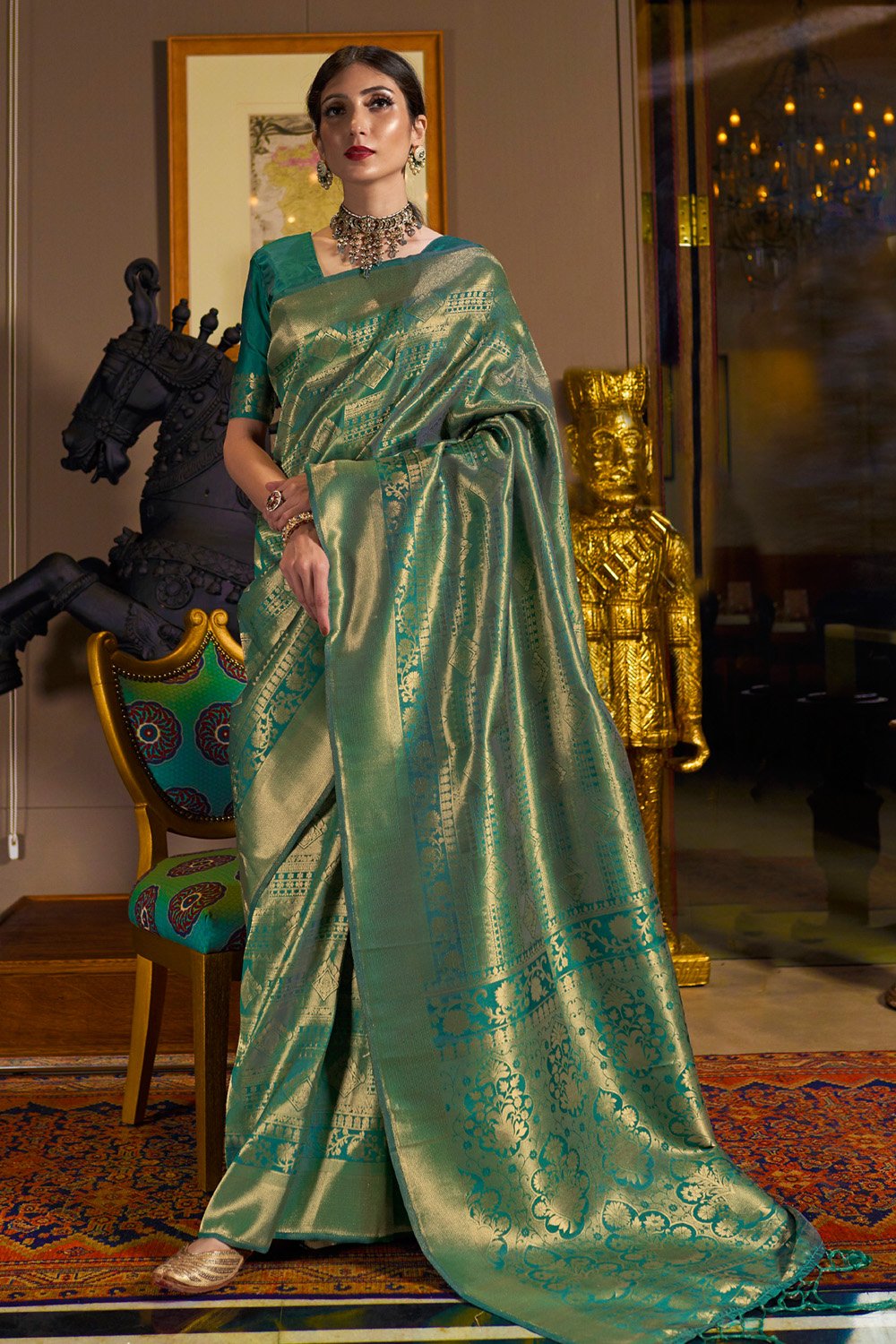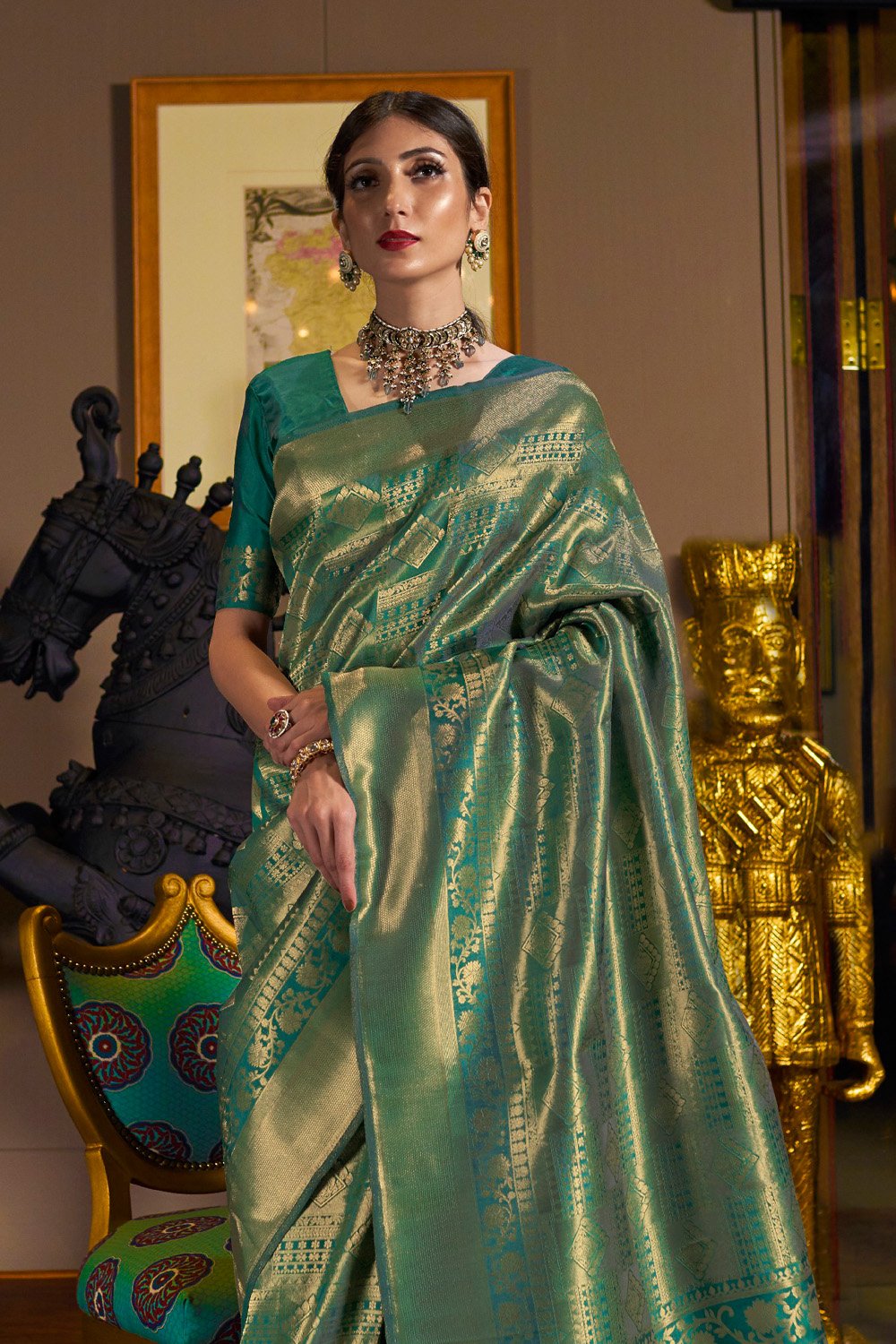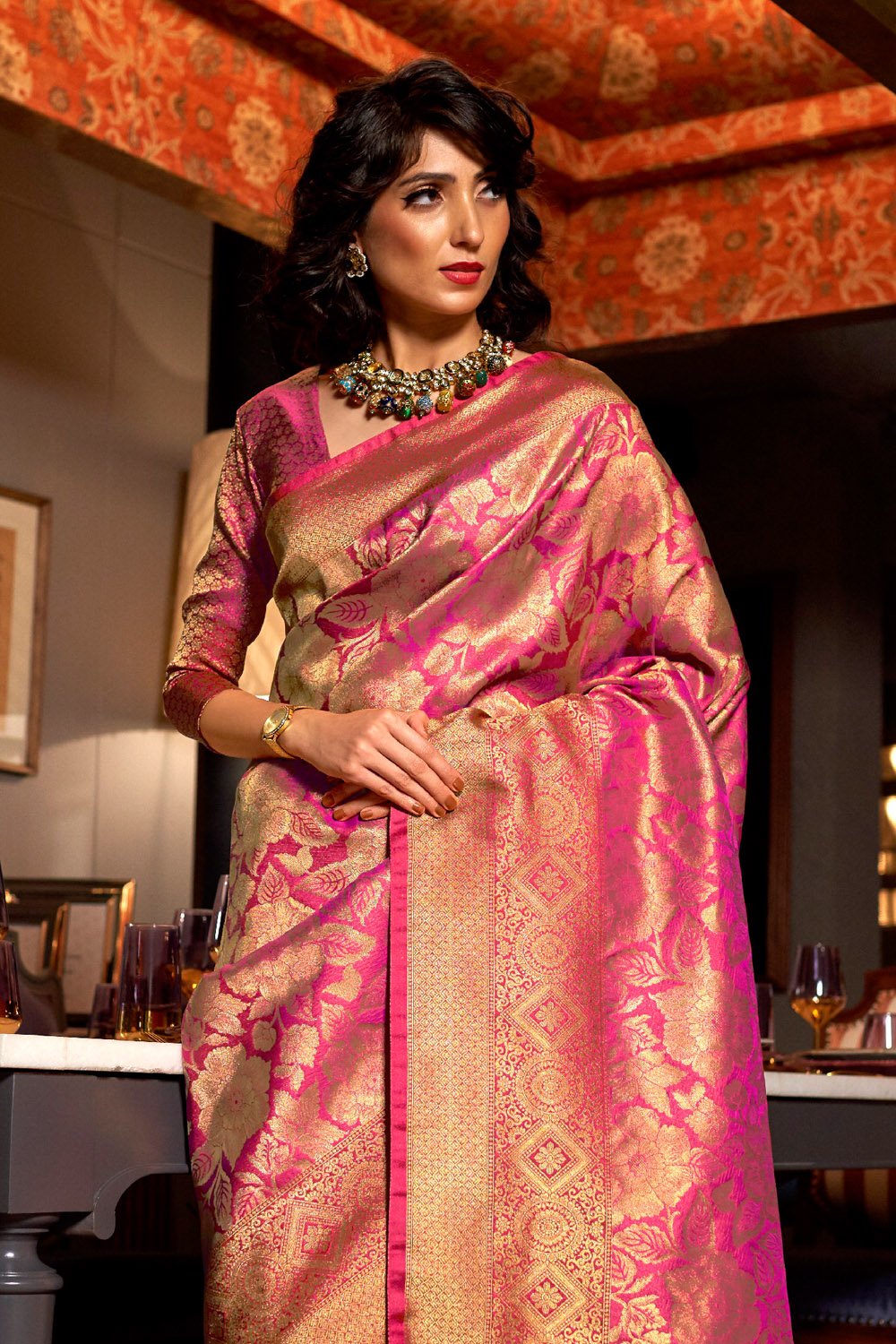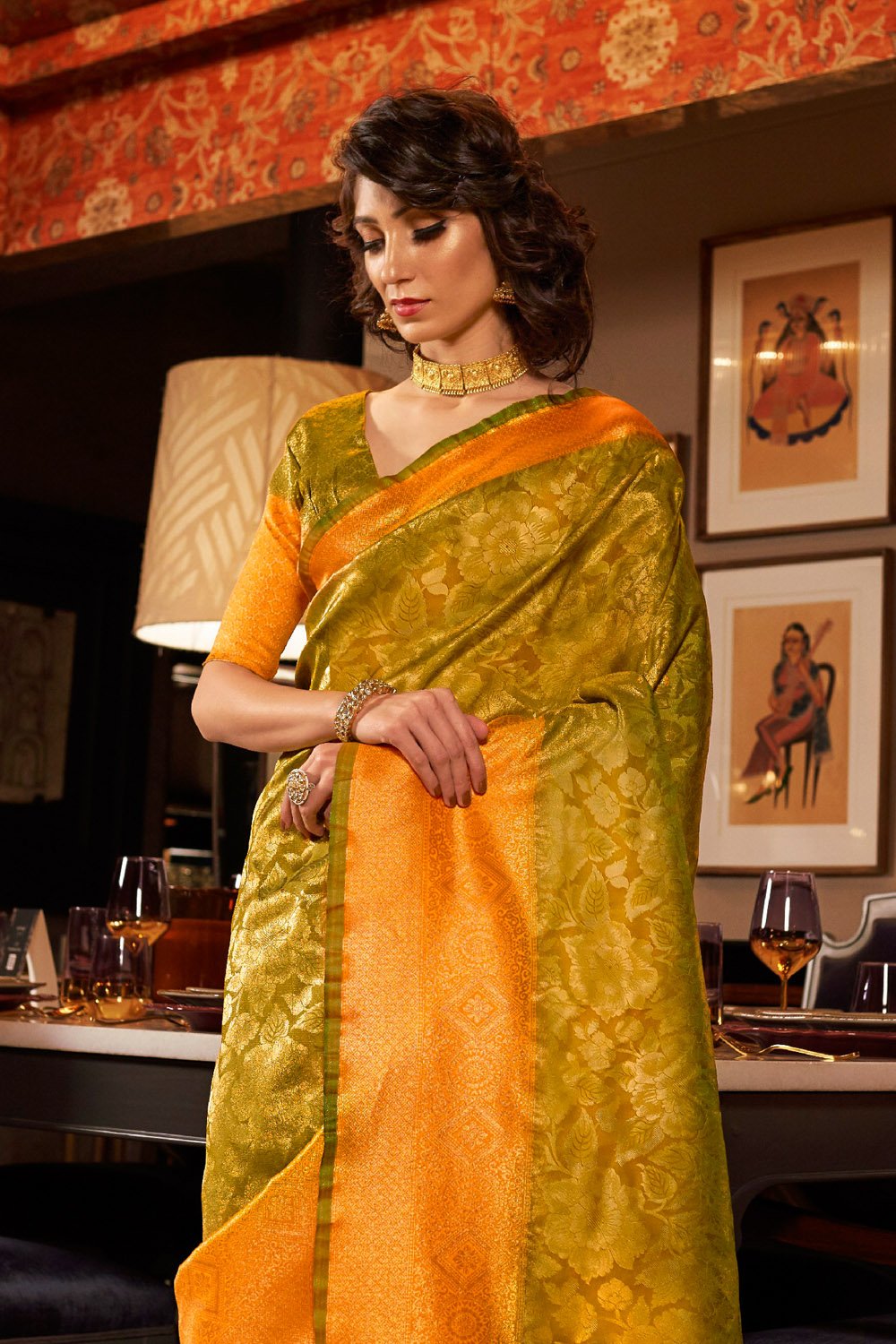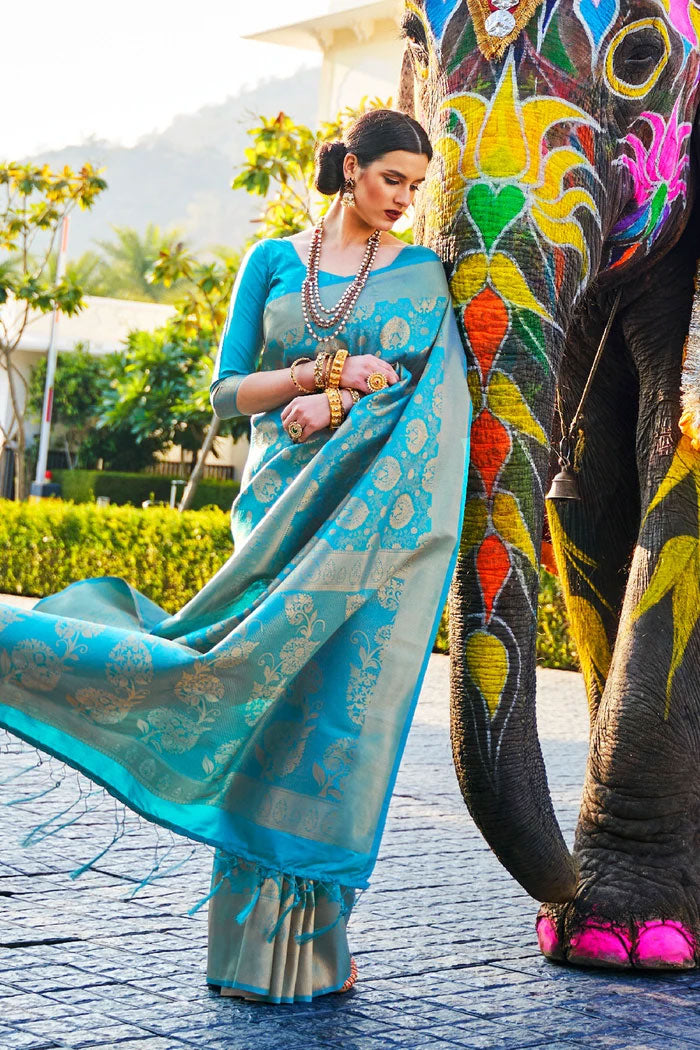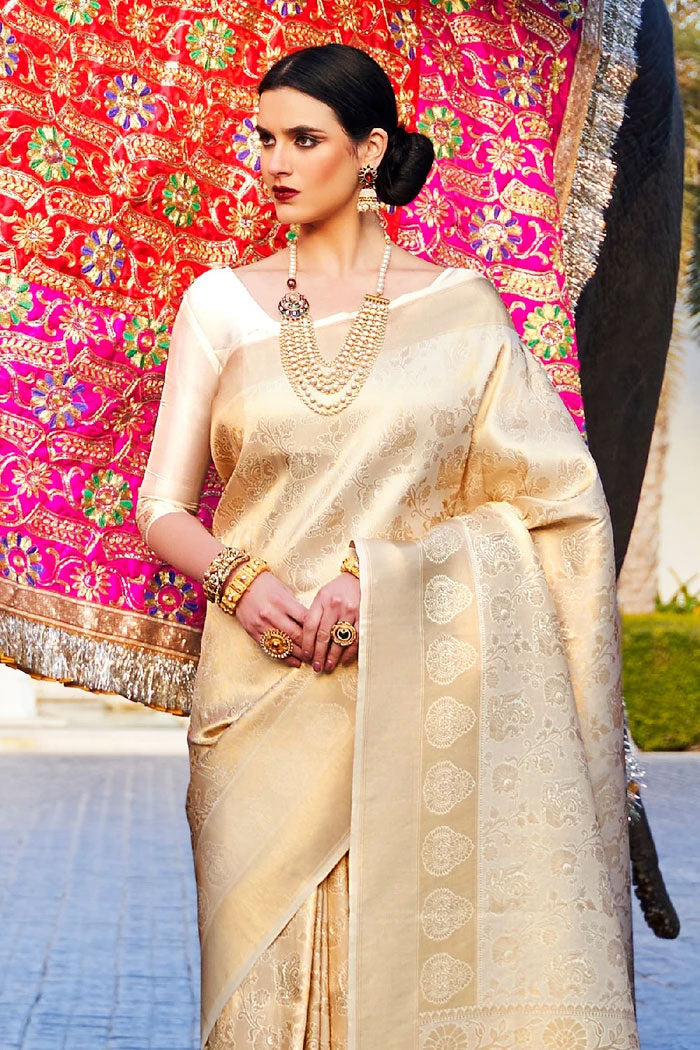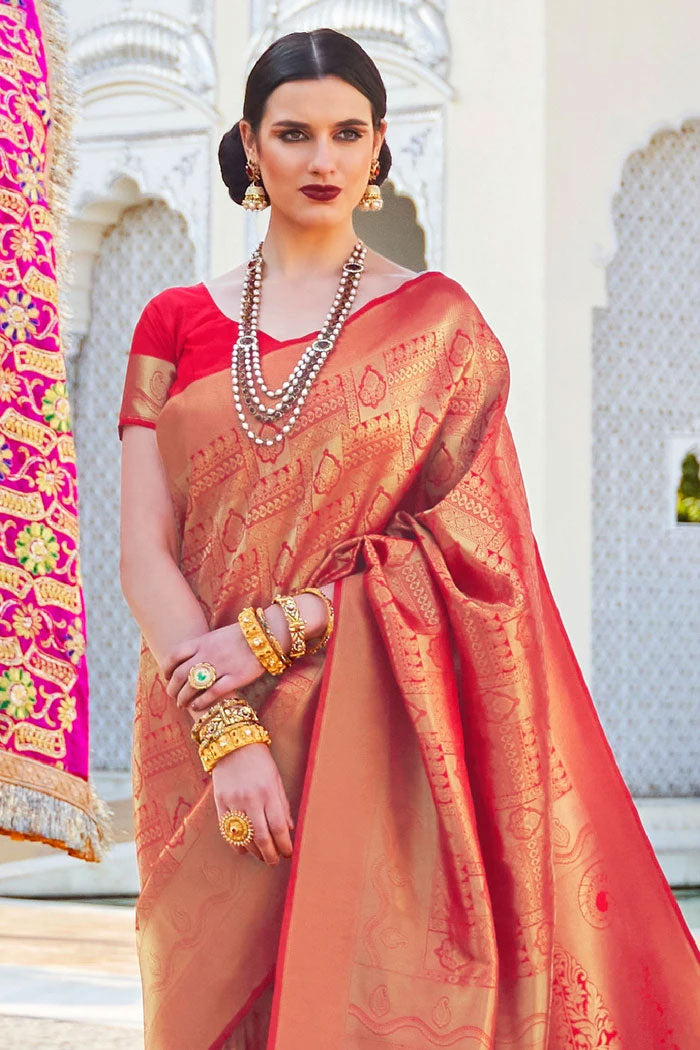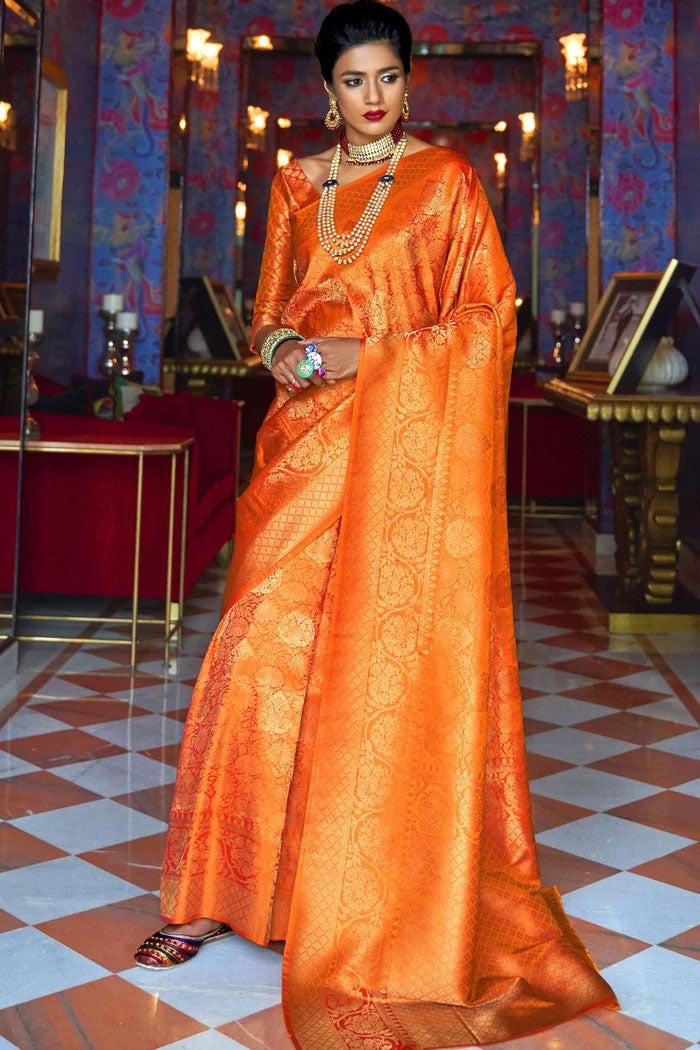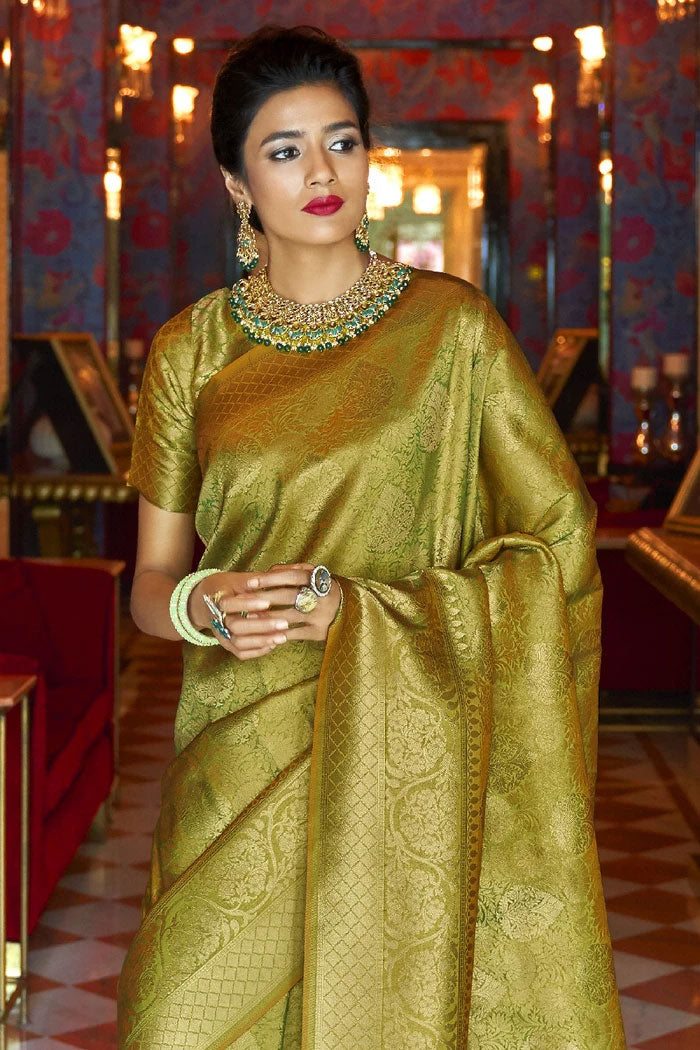Sort by
549 products
Kanjivaram Sarees
Latest Trends In Kanjivaram Sarees
Kanjivaram Saree: The Epitome of South Indian Traditional Elegance
The Kanjivaram Saree, also known as the Kanchipuram Saree, is a handwoven saree that originated in the town of Kanchipuram, Tamil Nadu. These sarees are made from pure mulberry silk and are characterized by their intricate designs, vibrant colors, and exquisite zari work.
Kanjivaram sarees are an integral part of South Indian weddings and are a must-have in every bride's trousseau. These sarees are also popular for their durability, making them an ideal choice for festive occasions.
The traditional Kanjivaram saree features designs inspired by nature, such as peacock motifs, flowers, and leaves. These sarees are usually available in shades of red, green, pink, and yellow.
Handwoven by skilled weavers, each Kanjivaram saree takes several weeks to complete. The intricate designs are woven using gold and silver threads, also known as zari, giving the saree a rich and luxurious look.
Kanjivaram sarees are available in a wide range of designs and styles, catering to every taste and occasion. From pure silk Kanjivaram sarees to bridal Kanjivaram sarees, there is a saree for every need.
Designer Kanjivaram sarees are gaining popularity in recent times, featuring contemporary designs and patterns, while still retaining the traditional charm of the saree.
Shopping for Kanjivaram sarees online has made it easier for buyers to access a wide range of sarees from the comfort of their homes. Buyers can browse through various designs, colors, and price ranges to find the perfect saree for their needs.
In conclusion, the Kanjivaram saree is a testament to the rich cultural heritage of South India. With its exquisite designs and intricate zari work, it is no wonder that this saree has been a favorite among women for generations. Whether it's for a wedding or a festive occasion, a Kanjivaram saree is sure to make heads turn.
What is so Special about Mysilklove Kanjivaram sarees?
Kanjeevaram sarees are traditional garment that is known for their luxurious fabric, intricate patterns and designs, and vibrant colours. They are made from a combination of silk and gold or silver zari thread, which is woven into intricate patterns and designs. Kanjeevaram sarees are often worn on special occasions such as weddings, religious ceremonies, and festivals, and are highly prized for their beauty and cultural significance. They are also known for their durability and comfort, as the silk fabric is lightweight and breathable.
Why Wear A Kanjivaram Saree?
There are many reasons why someone might choose to wear a Kanjivaram saree. Kanjivaram or Kanchipuram sarees are a type of saree from the city of Kanchipuram in the state of Tamil Nadu, India. These sarees are known for their intricate silk weaving and beautiful designs, and are considered to be a luxurious and prestigious item of clothing.
Some reasons why someone might wear a Kanjivaram saree include:
- The saree is considered to be a luxurious and prestigious item of clothing. Because of the fine quality of the silk and the intricate weaving and embroidery, Kanjivaram sarees are often considered to be a luxurious and prestigious item of clothing. This makes them a popular choice for special occasions, such as weddings, religious festivals, and other important events.
- The saree is comfortable to wear. Kanjivaram sarees are made up of silk, which is a lightweight and breathable fabric. This makes the saree comfortable to wear, even in hot weather, and allows for easy movement and flexibility.
- The saree is a traditional and cultural choice. In India, Kanjivaram sarees are a traditional and cultural choice of clothing and are often considered to be an essential part of a woman's wardrobe. Wearing a Kanjivaram saree can be a way to connect with and celebrate the rich cultural heritage of the region.
Types of Kanjivaram sarees
- Kanjeevaram sarees, also known as Kanchipuram sarees, are traditional handwoven sarees that originated in the town of Kanchipuram in the Tamil Nadu state of India. These sarees are known for their distinctive design, luxurious fabric, and vibrant colors, and are considered a hallmark of Indian heritage and culture.There are several different types of Kanjeevaram sarees, each with its own unique characteristics and features:
- Traditional Kanjeevaram sarees: These sarees are made using traditional techniques and feature intricate patterns and designs, bold and vibrant colors, and a gold or silver zari border. They are typically worn on special occasions such as weddings and festivals.
- Contemporary Kanjeevaram sarees: These sarees are made using modern techniques and feature more contemporary patterns and designs, as well as a wider range of colors and color combinations. They are suitable for a variety of occasions and can be dressed up or down depending on the occasion.
- Embroidered Kanjeevaram sarees: These sarees feature intricate embroidery and embellishments, such as beadwork and sequins, which add a touch of glamour and sparkle to the traditional Kanjeevaram saree. They are typically worn on special occasions and make a statement with their intricate and decorative designs.
- Temple border Kanjeevaram sarees: These sarees feature a distinctive border design that is inspired by the architecture and carvings of South Indian temples. They are typically made in bold and vibrant colors and are suitable for special occasions and formal events. Overall, there are many different types of Kanjeevaram sarees to choose from, each with its own unique characteristics and features.
Kanjivaram sarees for Wedding
A Kanjivaram saree is a traditional choice for a wedding outfit in India. The saree is typically paired with a silk blouse, and is often adorned with gold and silver brocade and other intricate embroidery. The saree is draped around the body in the traditional way, with one end tucked into the waistband at the back and the other end draped over the shoulder.
In addition to its beauty and elegance, a Kanjivaram saree is also a practical choice for a wedding outfit because it is comfortable to wear and allows for easy movement. The saree is lightweight and airy, making it suitable for wear in hot weather, and the fabric drapes beautifully, allowing the wearer to move and dance with ease.
Overall, a Kanjivaram saree is a beautiful and elegant choice for a wedding outfit, and is a traditional and cultural choice for many brides in India.
How to Style Kanjivaram Saree
Here are some tips on how to style a Kanjivaram saree:
- First, choose a saree that complements your body type and skin tone.
- Drape the saree around your waist, with the pleats facing toward the front.
- Tuck the end of the saree into your waistband securely.
- Next, take the long end of the saree and drape it over your left shoulder.
- Adjust the pleats and the end of the saree to ensure a neat and tidy appearance.
- Add accessories, such as a statement necklace or earrings, to complete the look.
- Tie your hair up in a bun or a braid to show off the saree's beautiful neckline.
- Finally, add a touch of makeup, such as a bold lip color or smoky eye, to enhance your overall appearance.
How to maintain Kanjivaram Sarees
- Kanjivaram or Kanchipuram sarees are a type of saree from the city of Kanchipuram in the state of Tamil Nadu, India. These sarees are known for their intricate silk weaving and beautiful designs, and are often considered to be a luxurious and prestigious item of clothing. If you're wondering how to maintain your Kanjivaram sarees, here are a few tips:
- Store the saree properly. Kanjivaram sarees are delicate and should be stored carefully to avoid damage. Hang the saree on a wide, padded hanger to prevent it from getting wrinkled or creased. Avoid folding the saree, as this can cause the fabric to the crease and the embroidery to become misaligned.
- Avoid exposing the saree to direct sunlight or heat. Kanjivaram sarees are made from silk, which can fade or discolour if exposed to direct sunlight or heat for prolonged periods of time. Avoid hanging the saree in direct sunlight, and avoid storing it in a hot, humid place.
- Dry clean the saree regularly. Kanjivaram sarees are made from silk and are often embellished with gold and silver brocade, which can be difficult to clean at home. To keep your saree looking its best, have it professionally dry cleaned on a regular basis.
- Handle the saree with care. Kanjivaram sarees are delicate and should be handled with care to avoid damaging the fabric or the embroidery. Avoid pulling or tugging on the saree, and avoid wearing it in situations where it may get caught or snagged.
- Avoid using harsh chemicals or detergents. Kanjivaram sarees are made from silk and are often embellished with gold and silver brocade, which can be damaged by harsh chemicals or detergents. Avoid using these products to clean your saree, and only use mild, silk-friendly cleaning products when necessary.
- Overall, the key to maintaining your Kanjivaram sarees is to store them properly, avoid exposing them to direct sunlight or heat, have them professionally dry cleaned regularly, handle them with care, and avoid using harsh chemicals or detergents. By following these tips, you can keep your Kanjivaram sarees looking beautiful and luxurious for many years to come.
Frequently Asked Questions (FAQs)
1. Is Kanjivaram and Kanchipuram same?
Kanjeevaram and Kanchipuram sarees are the same thing. They are both silk sarees that are known for their intricate designs and are traditionally woven in the town of Kanchipuram in Tamil Nadu, India. They are often worn on special occasions such as weddings and are considered to be among the most luxurious and traditional Indian sarees.
2. Which place is famous for kanjivaram saree?
Kanchipuram, also known as Kanjeevaram, is a city located in the state of Tamil Nadu, India, and it is famous for its silk sarees, known as Kanjeevaram or Kanchipuram sarees. These sarees are known for their intricate designs, bright colors, and high quality silk. They are handwoven by skilled weavers, and are considered to be among the most luxurious and traditional Indian sarees. Many people from all over India and abroad visit Kanchipuram to purchase these sarees.
3. When should we wear kanjivaram saree?
Kanjeevaram or Kanchipuram sarees are traditionally worn on special occasions such as weddings, religious ceremonies, and festivals in South India, particularly in Tamil Nadu. They are considered to be quite formal and luxurious, and are often worn by women as a symbol of elegance and tradition. They are also worn on other special events and ceremonies, including engagement, baby shower, housewarming, and other auspicious occasions.
It is also worn for traditional and cultural events such as Navratri, Diwali, Dussera, Pongal and other South Indian festivals. They can also be worn on other formal events, like parties, and events such as conferences, and business meetings.
4. What is special about Kanjivaram saree?
The speciality of the saree lies texture, glimmer, permanence and refinement which is why it is popularly known as the queen of all sarees. The material used is the heavy Kanchipuram silk and is also a bit expensive because of its finesse and weight. The weight of the saree determines or is the sole parameter of its quality. The heavier the saree the better it is.
5.What is the difference between Kanjivaram and Banarasi saree?
Banarasi sarees and kanjivaram sarees are the two most adored Indian sarees. They both come under the category of finely woven silk sarees and yes both are equally famous worldwide. Since both have their unique specialties, you might wonder how to choose the right one for your special occasion. The luxurious kanjivaram sarees are woven entirely using mulberry silk thread with a joint placed between the pallu and the body of the saree, called pinti.Banarasi sarees are created using intricately prepared silk. These silk sarees are made of light hues with beautiful patterns on both sides of the border. The lovely designs of the kanjivaram sarees are based on Hindu mythologies, historical events, and religious structures. The broad border of these sarees is created with beautiful patterns like checks, stripes, and flowers. The artwork in banarasi sarees are consist of Mughal pictures, floral, or leaflike motifs, or bel, a string of leaves that is created around the edge of the border.
There is an enormous variety of kanjivaram sarees when it comes to designs, patterns, and styles. Some of the most adored kanjivaram sarees are temple border kanjivaram sarees, plain kanchipuram saree, traditional kanchipuram saree, kanjivaram saree with silk border, floral weave kanjivaram saree, etc. Banarasi sarees hold a considerable influence on the silk sarees markets, because of their diverse range of classifications. Some of the highly preferred banarasi sarees are shattir banarasi saree, shikargarh banarasi saree, tanchoi banarasi saree, tussar banarasi saree, georgette banarasi saree, etc.
Kanjivaram Sarees Price List
Explore our all collections
Ajrakh Sarees | Banarasi Sarees | Bandhani Sarees | Best Seller Sarees | Black Sarees | Blue Sarees | Chikankari Sarees | Cream Sarees | Dresses | Dresses and Salwar suits | Golden Sarees | Green Sarees | Grey Sarees | Hand Block Printed Sarees | Kalamkari Sarees | Kanjivaram Sarees | Kashmiri Sarees | Latest Saree Designs | Lehenga | Linen Sarees | Orange Sarees | Organza Sarees | Paithani Sarees | Party Wear Sarees | Patola Sarees | Pink Sarees | Printed Sarees | Purple Sarees | Raw Silk Sarees | Red Sarees | Salwar Suit & Dresses | Sarees above 7500 | Sarees above Rs.10000 | Sarees below Rs.3000 | Sarees for Farewell | Sarees from Rs.3000 to Rs.5000 | Sarees From Rs.5000 to Rs.7500 | Sarees from Rs.7500 to Rs.10000 | Satin Sarees | Silk Sarees | South Silk Sarees | Summer Sarees | Tussar Sarees | Upto 80% OFF Clearance Sale | White Sarees | Yellow Sarees |
MySilkLove Assured
Buy with confidence
Direct from Manufacturers
No middlemen involved
Satisfied or refunded
Amount is refunded if you don't like the product.
Good quality fabric
Perfect finish, stain free products
Sustainable
Ethical manufacturing, fair wages for labours.

